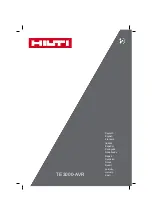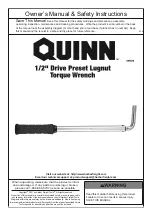
Refer All Communications to the Nearest
Ingersoll--Rand Office or Distributor.
Ingersoll--Rand Company 2002
Printed in U.S.A.
04578878
Form P7586--EU
Edition 2
July, 2002
INSTRUCTIONS FOR
MODELS 2915P1 AND 2915P3
SUPER DUTY IMPACTOOLS
Series 2915 Impactools are designed for use in heavy assembly work and machinery
maintenance.
IMPORTANT SAFETY INFORMATION ENCLOSED -- SAVE THESE INSTRUCTIONS
READ AND UNDERSTAND THIS MANUAL BEFORE OPERATING THIS PRODUCT
IT IS YOUR RESPONSIBILITY TO MAKE THIS SAFETY INFORMATION
AVAILABLE TO OTHERS THAT WILL OPERATE THIS PRODUCT
FAILURE TO OBSERVE THE FOLLOWING WARNINGS COULD RESULT IN INJURY
PLACING TOOL IN SERVICE
•
Always install, operate, inspect and maintain this
product in accordance with all applicable standards
and regulations (local, state, country, federal, etc.).
•
Always use clean, dry air at 90 psig (6.2 bar/620 kPa)
maximum air pressure at the inlet. Higher pressure
may result in hazardous situations including excessive
speed, rupture, or incorrect output torque or force.
•
Be sure all hoses and fittings are the correct size and
are tightly secured. See Dwg. TPD905--2 for a typical
piping arrangement.
•
Ensure an accessible emergency shut off valve has
been installed in the air supply line, and make others
aware of its location.
•
Do not use damaged, frayed or deteriorated air hoses
and fittings.
•
Keep clear of whipping air hoses. Shut off the
compressed air before approaching a whipping hose.
•
Always turn off the air supply and disconnect the air
supply hose before installing, removing or adjusting
any accessory on this tool, or before performing any
maintenance on this tool.
•
Do not lubricate tools with flammable or volatile
liquids such as kerosene, diesel or jet fuel. Use only
recommended lubricants.
•
Keep work area clean, uncluttered, ventilated and
illuminated.
•
Do not remove any labels. Replace any damaged label.
USING THE TOOL
•
Always wear eye protection when operating or
performing maintenance on this tool.
•
Always wear hearing protection when operating this
tool.
•
Always use Personal Protective Equipment
appropriate to the tool used and material worked.
This may include dust mask or other breathing
apparatus, safety glasses, ear plugs, gloves, apron,
safety shoes, hard hat and other equipment.
•
Prevent exposure and breathing of harmful dust and
particles created by power tool use.
Some dust created by power sanding, sawing,
grinding, drilling, and other construction
activities contains chemicals known to cause
cancer, birth defects or other reproductive harm.
Some examples of these chemicals are:
-- lead from lead based paints,
-- crystalline silica from bricks and cement and
other masonry products, and
-- arsenic and chromium from chemically
treated lumber.
Your risk from these exposures varies, depending
on how often you do this type of work. To reduce
your exposure to these chemicals: work in a well
ventilated area, and work with approved safety
equipment, such as those dust masks that are
specially designed to filter out microscopic
particles.
GB


































